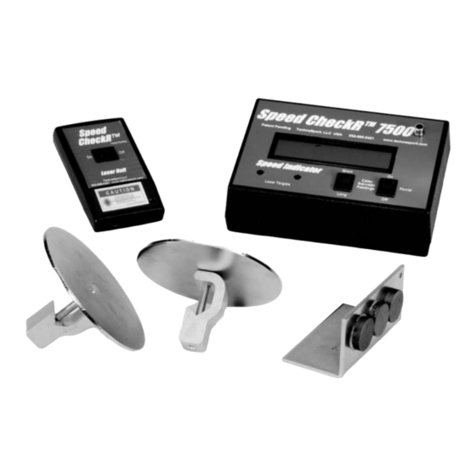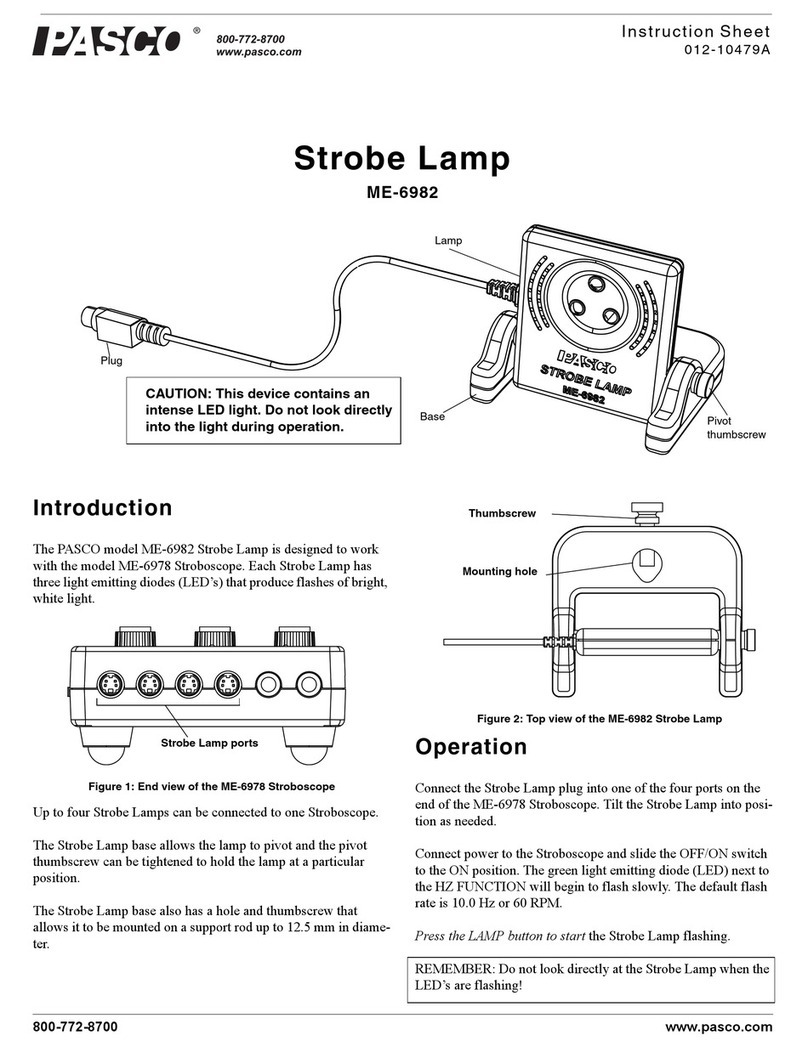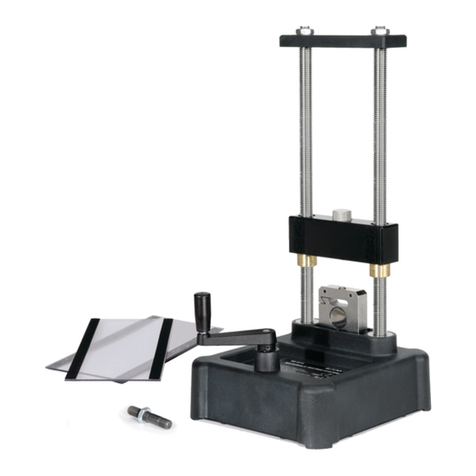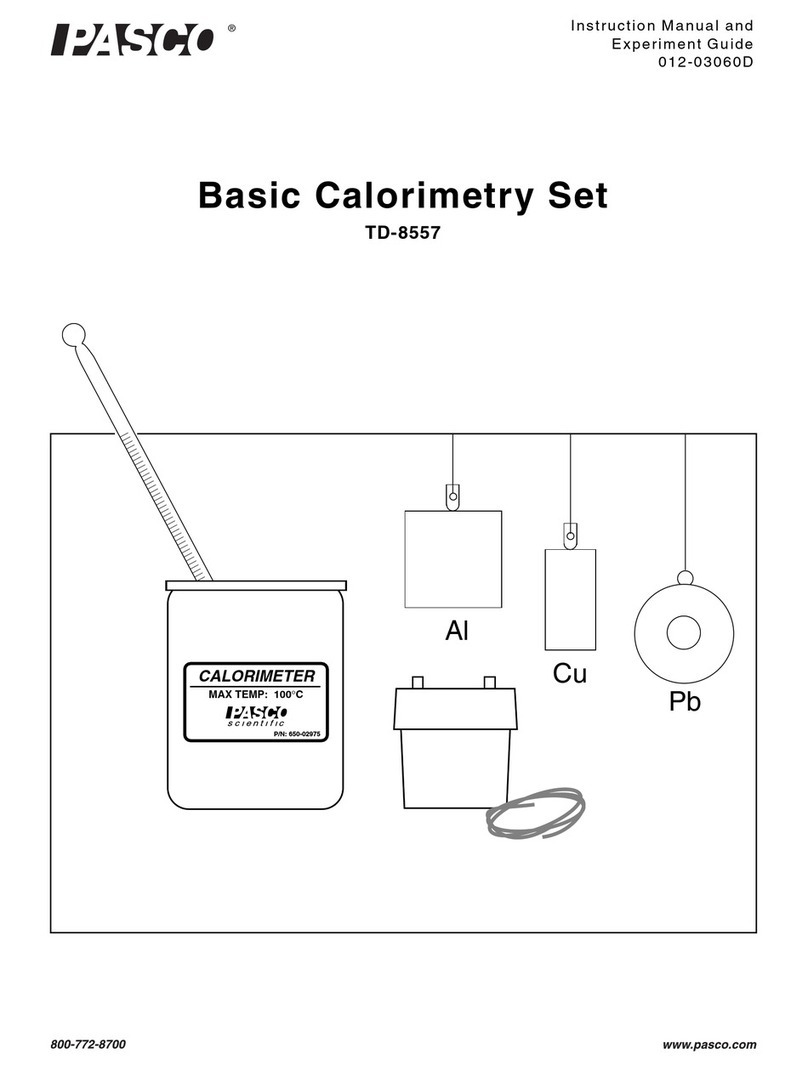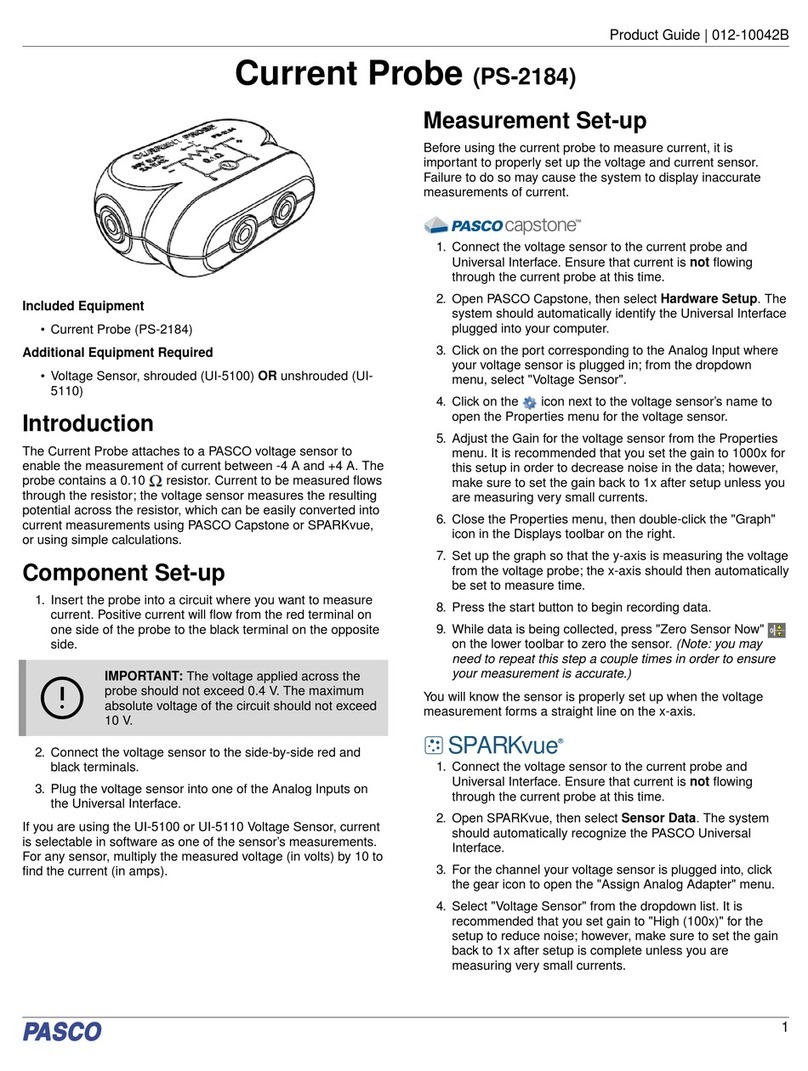
TRIGGER mode is indicated only by the FUNCTION LED and is
designed primarily for use with PASCO Photogates. For
example, connect a PASCO Photogate to the TRIGGER - IN
port and set the Stroboscope to the TRIGGER mode with a
Strobe Lamp attached. Press the LAMP button. The lamp will
flash each time that the photogate’s infrared beam is interrupted.
The 7-segment display continuously displays the external trigger
(TRIGGER - IN) display setting. The setting defaults to zero, so
there is essentially no delay between the trigger being received
and the lamp turning on. The COARSE and FINE controls may
be used to adjust the trigger delay time from 0 to 1000, with
each increment equaling one millisecond. The BRIGHTNESS
control is also active and may be adjusted from a relative
brightness level of 1 to 25.
Multiple Stroboscopes
TRIGGER IN/OUT may also be used to connect multiple
Stroboscope units when used in HZ or RPM modes. Similar to
usage with a Photogate, each unit flashes along with the first or
"primary" unit. There are three special considerations when
using the Strobe with the primary unit in HZ or RPM.
First, configure the primary controller to operate in HZ or RPM.
Configure each secondary unit to operate in TRIGGER mode.
Connect the stereo patch cable from the primary controller’s
TRIGGER-OUT jack to the secondary unit’s TRIGGER-IN jack.
A large number of Strobes could be connected this way.
NOTE: A stereo phone plug-to-stereo phone plug
cable is needed to connect two Stroboscopes
together.
Second, to obtain consistent brightness from the secondary
lamps, the secondary unit(s) will usually need to have their
brightness control adjusted to where the actual levels match that
of the primary Strobe controller. When equal brightness is
attained, the brightness level as shown on each display may not
match. Matching the light levels is best done by eye, without
regard to the numerical brightness level displayed.
Lastly, if used, the trigger delay will have to be adjusted with
care. If the secondary unit(s) delay time is set longer than the
time between triggers from the primary controller, the secondary
unit lamps will stop flashing or flash at an incorrect rate.
Proper operation using an external trigger requires that the
trigger source be "debounced". Use of ordinary mechanical
switches without debouncing circuitry can lead to multiple
flashes, as well as flashes whenever the switch changes state.
The Stroboscope supplies a TTL level signal for the trigger
output (TRIGGER - OUT) and can supply 5 volts (50 mA
maximum) from the stereo plug "tip" to power external switches.
The TRIGGER - OUT is designed to be connected to the
TRIGGER - IN on a second Stroboscope. The advantage of
being able to connect two (or more) Stroboscopes together is
that the number of Strobe Lamps, and therefore the total
brightness of each flash, can be increased.
Specifications and Accessories
Visit the product page at pasco.com/product/ME-6978 to view
the specifications and explore accessories. You can also
download support documents from the product page.
Technical Support
Need more help? Our knowledgeable and friendly Technical
Support staff is ready to answer your questions or walk you
through any issues.
Chat pasco.com
Phone 1-800-772-8700 x1004 (USA)
+1 916 462 8384 (outside USA)
Email support@pasco.com
Limited Warranty
For a description of the product warranty, see the Warranty and Returns page at
www.pasco.com/legal.
Copyright
This document is copyrighted with all rights reserved. Permission is granted to non-
profit educational institutions for reproduction of any part of this manual, providing
the reproductions are used only in their laboratories and classrooms, and are not
sold for profit. Reproduction under any other circumstances, without the written
consent of PASCO scientific, is prohibited.
Trademarks
PASCO and PASCO scientific are trademarks or registered trademarks of PASCO
scientific, in the United States and in other countries. All other brands, products, or
service names are or may be trademarks or service marks of, and are used to
identify, products or services of, their respective owners. For more information visit
www.pasco.com/legal.
Product end-of-life disposal
This electronic product is subject to disposal and recycling regulations
that vary by country and region.
It is your responsibility to recycle your electronic equipment per your
local environmental laws and regulations to ensure that it will be
recycled in a manner that protects human health and the environment.
To find out where you can drop off your waste equipment for recycling,
please contact your local waste recycle or disposal service, or the place where you
purchased the product.
The European Union WEEE (Waste Electronic and Electrical Equipment) symbol
on the product or its packaging indicates that this product must not be disposed of
in a standard waste container.
CE statement
This device has been tested and found to comply with the essential requirements
and other relevant provisions of the applicable EU Directives.
FCC statement
This device complies with part 15 of the FCC Rules.
Operation is subject to the following two conditions:
(1) This device may not cause harmful interference, and (2) this device must accept
any interference received, including interference that may cause undesired
operation.
Product Guide | 012-10467C
3












